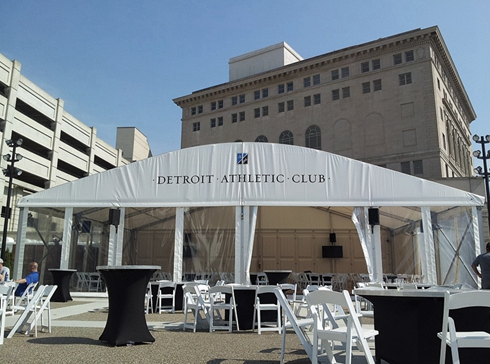When aluminum alloy tents encounter strong winds, targeted protective and emergency measures must be taken based on their structural characteristics (lightweight, modular design) to prevent structural damage or safety accidents. The specific handling methods are as follows:
1.
Inspect and reinforce structural connections
2.
1. Focus on checking the aluminum alloy frame joints (such as connectors between vertical poles and the ground, bolts between diagonal braces and main frames, and beam splices). Ensure all fasteners (bolts, pins, etc.) are not loose; retighten them with a wrench if necessary.
2. For tents equipped with side guy ropes or ground anchors, confirm that the tension is uniform and that the ground anchors (such as steel rods, counterweights) are buried deeply enough or fixed securely to prevent being pulled up by the wind.
3.
Optimize the tent fabric and additional facilities
4.
1. Tighten the tent fabric: Ensure the fabric fits tightly with the frame, and edge buckles or ropes are firmly fixed. This prevents the fabric from being blown loose and billowed by the wind, which could generate extra tension and tear the structure.
2. Remove vulnerable components: Temporarily dismantle detachable side curtains, sunshades, hanging lamps/billboards, etc., to reduce wind resistance and the risk of falling objects.
3. Check the drainage system: Clean the roof gutters and ground drainage ditches to prevent accumulated water from increasing the tent's load when strong winds are accompanied by rain.
5.
Evaluate wind force levels and formulate emergency plans
6.
1. Monitor weather forecasts. If winds are expected to reach level 6 or above (wind speed 10.8-13.8 m/s), stop using the tent in advance and evacuate people and items inside.
2. For large temporary tents (e.g., for exhibitions or events), confirm the wind resistance level with the installer (usually designed to withstand level 8-10 winds). If the limit is exceeded, initiate dismantling or reinforcement plans.
1.
Prohibit entry and keep away from dangerous areas
2.
1. Demarcate a warning zone to prevent people from approaching the tent, especially areas where diagonal braces or vertical poles might topple, and where torn fabric fragments could fly.
3.
Dynamically observe structural conditions
4.
1. If the tent shows obvious shaking, frame deformation, loose ground anchors, or torn fabric, immediately move away and contact professionals. Do not enter 擅自 to reinforce it.
2. For tents fixed to the ground, if the foundation (e.g., concrete embedded parts) loosens, temporarily add counterweights (such as sandbags or steel blocks) to press it down. However, avoid excessive local load that could cause structural imbalance.
5.
Extreme situations: 果断 evacuation and loss control
6.
1. If winds continue to strengthen (e.g., exceeding level 10) and the structure shows irreversible deformation (e.g., bent vertical poles, tilted main frames), prioritize personnel safety, abandon the tent, and handle the debris after the wind stops.
1.
Comprehensively check for structural damage
2.
1. Inspect whether the aluminum alloy frame is bent or broken, whether joint connectors are deformed or detached, and whether the ground anchor foundation is loose.
2. Assess tent fabric damage, record tear locations and severity, and determine if repair or replacement is needed.
3.
Step-by-step repair and safety confirmation
4.
1. First repair the frame structure: Replace damaged vertical poles, diagonal braces, or bolts; retighten all joints to ensure structural stability.
2. Repair or replace the tent fabric: Patch small tears with special tape or patches; replace the entire fabric for large-area damage to avoid water leakage or uneven stress during reuse.
3. Test functionality: After repair, conduct simple tension tests (e.g., manually shaking the frame, checking fabric tightness) to confirm no safety hazards before resuming use.
The wind resistance of aluminum alloy tents depends on structural design, installation quality, and pre-protection. The core principles are: advance prevention is better than post-disaster treatment, and personnel safety takes priority over property protection. For long-term use tents, it is recommended to have professional teams conduct regular maintenance to ensure the frame, connectors, and ground anchor systems are always in good condition to cope with sudden strong winds.


Hi! Welcome back.
How are you doing?

+86 17712768856
NO.1319-1 Xicheng Rood Qingyang village, Jiangyin City,Jiangsu Province,China
Subscribe today and get educated and entertained with the monthly SYXTENT email